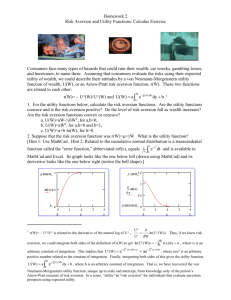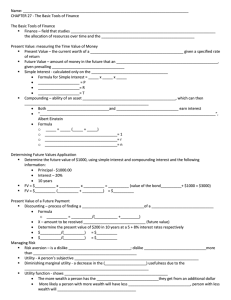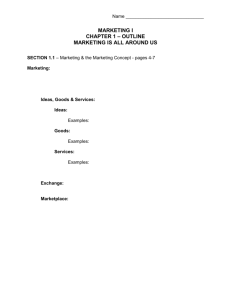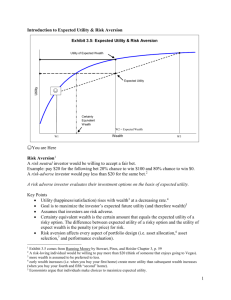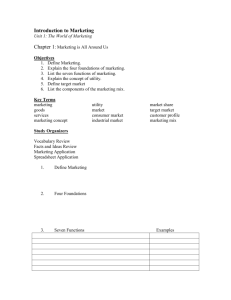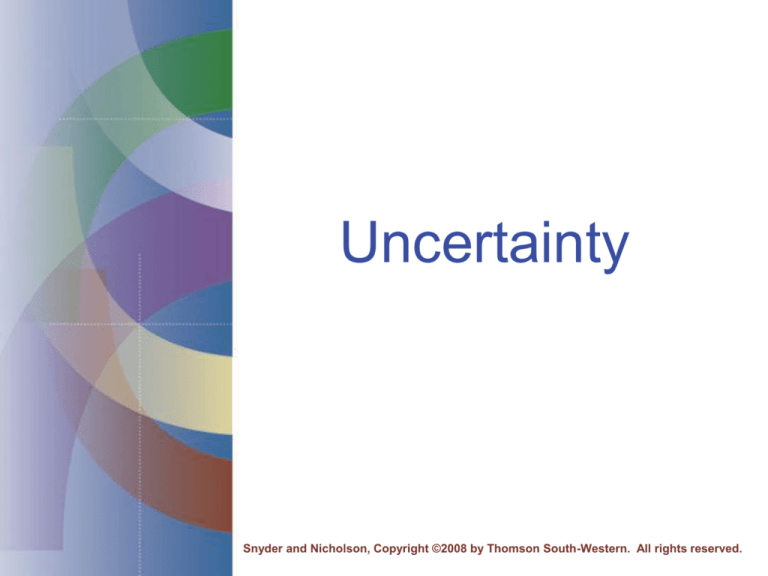
Uncertainty
Snyder and Nicholson, Copyright ©2008 by Thomson South-Western. All rights reserved.
Mathematical Statistics
• A random variable is a variable that
records, in numerical form, the possible
outcomes from some random event
• The probability density function (PDF)
shows the probabilities associated with
the possible outcomes from a random
variable
Mathematical Statistics
• The expected value of a random variable
is the outcome that will occur “on
average”
n
E( X ) x i f x i
i 1
E( X ) x f x dx
Mathematical Statistics
• The variance and standard deviation
measure the dispersion of a random
variable about its expected value
2
n
2x x i E x f x i
i 1
2x
2
x
E
x
f x dx
2
x x
Expected Value
• Games which have an expected value of
zero (or cost their expected values) are
called fair games
– a common observation is that people would
prefer not to play fair games
St. Petersburg Paradox
• A coin is flipped until a head appears
• If a head appears on the nth flip, the
player is paid $2n
x1 = $2, x2 = $4, x3 = $8,…,xn = $2n
• The probability of getting of getting a
head on the ith trial is (½)i
1=½, 2= ¼,…, n= 1/2n
St. Petersburg Paradox
• The expected value of the St. Petersburg
paradox game is infinite
1
E ( X ) i x i 2
2
i 1
i 1
i
i
E ( X ) 1 1 1 ... 1
• Because no player would pay a lot to
play this game, it is not worth its infinite
expected value
Expected Utility
• Individuals do not care directly about the
dollar values of the prizes
– they care about the utility that the dollars
provide
• If we assume diminishing marginal utility of
wealth, the St. Petersburg game may
converge to a finite expected utility value
– this would measure how much the game is
worth to the individual
Expected Utility
• Expected utility can be calculated in the
same manner as expected value
n
EU iU ( xi )
i 1
• Because utility may rise less rapidly than
the dollar value of the prizes, it is
possible that expected utility will be less
than the monetary expected value
Preferences Under Uncertainty
• Expected utility Property
Expected utility function (or
von Neumann-Morgenstern utility function)
has the property that expected utility can be
written in the form
π1u(C1) + (1-π1)u(C2)
Where C1 is consumption level that occurs with probability π1
and C2 is consumption level that occurs with probability 1-π1
Preferences Under Uncertainty
• It seems possible that utility function in
the case where consumption choices
are uncertain should have expected
utility property as ultimately only one
consumption choice will actually occur
Preferences Under Uncertainty
• Independence assumption
With uncertainty, choices under different
outcomes should be independent (as
you can only be at one state of nature)
Hence we expect the utility function to
take the form
U(C1,C2,π1,1- π1) = π1u(C1) + (1-π1)u(C2)
True if we have expected utility function
Risk Aversion
• Two lotteries may have the same
expected value but differ in their riskiness
– flip a coin for $1 versus $1,000
• Risk refers to the variability of the
outcomes of some uncertain activity
• When faced with two gambles with the
same expected value, individuals will
usually choose the one with lower risk
Risk Aversion
• In general, we assume that the marginal
utility of wealth falls as wealth gets larger
– a flip of a coin for $1,000 promises a small
gain in utility if you win, but a large loss in
utility if you lose
– a flip of a coin for $1 is inconsequential as
the gain in utility from a win is not much
different as the drop in utility from a loss
Risk Aversion
Utility (U)
U(W) is a von Neumann-Morgenstern
utility index that reflects how the individual
feels about each value of wealth
U(W)
The curve is concave to reflect the
assumption that marginal utility
diminishes as wealth increases
Wealth (W)
Risk Aversion
Utility (U)
Suppose that W* is the individual’s current
level of income
U(W)
U(W*)
U(W*) is the individual’s
current level of utility
W*
Wealth (W)
Risk Aversion
• Suppose that the person is offered two
fair gambles:
– a 50-50 chance of winning or losing $h
Uh(W*) = ½ U(W* + h) + ½ U(W* - h)
– a 50-50 chance of winning or losing $2h
U2h(W*) = ½ U(W* + 2h) + ½ U(W* - 2h)
Risk Aversion
Utility (U)
The expected value of gamble 1 is Uh(W*)
U(W)
U(W*)
Uh(W*)
W* - h
W*
W* + h
Wealth (W)
Risk Aversion
Utility (U)
The expected value of gamble 2 is U2h(W*)
U(W)
U(W*)
U2h(W*)
W* - 2h
W*
W* + 2h
Wealth (W)
Risk Aversion
U(W*) > Uh(W*) > U2h(W*)
Utility (U)
U(W)
U(W*)
Uh(W*)
U2h(W*)
W* - 2h
W* - h
W*
W* + h
W* + 2h
Wealth (W)
Risk Aversion
• The person will prefer current wealth to
that wealth combined with a fair gamble
• The person will also prefer a small
gamble over a large one
Risk Aversion and Insurance
• The person might be willing to pay
some amount to avoid participating in a
gamble
• This helps to explain why some
individuals purchase insurance
Risk Aversion and insurance
Utility (U)
W ” provides the same utility as
participating in gamble 1
U(W)
U(W*)
Uh(W*)
The individual will be
willing to pay up to
W* - W ” to avoid
participating in the
gamble
W* - h W ” W*
W* + h
Wealth (W)
Risk Aversion and Insurance
• An individual who always refuses fair
bets is said to be risk averse
– will exhibit diminishing marginal utility of
income
– will be willing to pay to avoid taking fair
bets
Willingness to Pay for Insurance
• Consider a person with a current wealth
of $100,000 who faces a 25% chance of
losing his automobile worth $20,000
• Suppose also that the person’s von
Neumann-Morgenstern utility index is
U(W) = ln (W)
Willingness to Pay for Insurance
• The person’s expected utility will be
E(U) = 0.75U(100,000) + 0.25U(80,000)
E(U) = 0.75 ln(100,000) + 0.25 ln(80,000)
E(U) = 11.45714
• In this situation, a fair insurance premium
would be $5,000 (25% of $20,000)
Willingness to Pay for Insurance
• The individual will likely be willing to pay
more than $5,000 to avoid the gamble. How
much will he pay?
E(U) = U(100,000 - x) = ln(100,000 - x) = 11.45714
100,000 - x = e11.45714
x = 5,426
• The maximum premium is $5,426
Measuring Risk Aversion
• The most commonly used risk aversion
measure was developed by Pratt
U " (W )
r (W )
U ' (W )
• For risk averse individuals, U”(W) < 0
– r(W) will be positive for risk averse
individuals
– r(W) is not affected by which von
Neumann-Morganstern ordering is used
Measuring Risk Aversion
• The Pratt measure of risk aversion is
proportional to the amount an individual
will pay to avoid a fair gamble
Measuring Risk Aversion
• Let h be the winnings from a fair bet
E(h) = 0
• Let p be the size of the insurance
premium that would make the individual
exactly indifferent between taking the
fair bet h and paying p with certainty to
avoid the gamble
E[U(W + h)] = U(W - p)
Measuring Risk Aversion
• We now need to expand both sides of
the equation using Taylor’s series
• Because p is a fixed amount, we can
use a simple linear approximation to the
right-hand side
U(W - p) = U(W) - pU’(W) + higher order terms
Measuring Risk Aversion
• For the left-hand side, we need to use a
quadratic approximation to allow for the
variability of the gamble (h)
E[U(W + h)] = E[U(W) - hU’(W) + h2/2 U” (W)
+ higher order terms
E[U(W + h)] = U(W) - E(h)U’(W) + E(h2)/2 U” (W)
+ higher order terms
Measuring Risk Aversion
• Remembering that E(h)=0, dropping the
higher order terms, and substituting k
for E(h2)/2, we get
U (W ) pU ' (W ) U (W ) kU " (W )
kU " (W )
p
kr (W )
U ' (W )
Risk Aversion and Wealth
• It is not necessarily true that risk aversion
declines as wealth increases
– diminishing marginal utility would make
potential losses less serious for high-wealth
individuals
– however, diminishing marginal utility also
makes the gains from winning gambles less
attractive
• the net result depends on the shape of the utility
function
Risk Aversion and Wealth
• If utility is quadratic in wealth
U(W) = a + bW + cW 2
where b > 0 and c < 0
• Pratt’s risk aversion measure is
U " (W )
2c
r (W )
U (W ) b 2cW
• Risk aversion increases as wealth
increases
Risk Aversion and Wealth
• If utility is logarithmic in wealth
U(W) = ln (W )
where W > 0
• Pratt’s risk aversion measure is
U " (W ) 1
r (W )
U (W ) W
• Risk aversion decreases as wealth
increases
Risk Aversion and Wealth
• If utility is exponential
U(W) = -e-AW = -exp (-AW)
where A is a positive constant
• Pratt’s risk aversion measure is
U " (W ) A2e AW
r (W )
A
AW
U (W )
Ae
• Risk aversion is constant as wealth
increases
Relative Risk Aversion
• It seems unlikely that the willingness to
pay to avoid a gamble is independent of
wealth
• A more appealing assumption may be
that the willingness to pay is inversely
proportional to wealth
Relative Risk Aversion
• This relative risk aversion formula is
U " (W )
rr (W ) Wr (W ) W
U ' (W )
Relative Risk Aversion
• The power utility function
U(W) = WR/R
for R < 1, 0
exhibits diminishing absolute risk
aversion
U " (W )
(R 1)W R 2
(R 1)
r (W )
R 1
U ' (W )
W
W
but constant relative risk aversion
rr (W ) Wr (W ) (R 1) 1 R
The Portfolio Problem
• How much wealth should a risk-averse
person invest in a risky asset?
– the fraction invested in risky assets should
be smaller for more risk-averse investors
The Portfolio Problem
• Assume an individual has wealth (W0)
to invest in one of two assets
– one asset yields a certain return of rf
– one asset’s return is a random variable, rr
The Portfolio Problem
•
If k is the amount invested in the risky
asset, the person’s wealth at the end
of one period will be
W = (W0 – k)(1 + rf) + k(1 + rr)
W = W0(1 + rf) + k(rr – rf)
The Portfolio Problem
•
W is now a random variable
– it depends on rr
•
k can be positive or negative
– can buy or sell short
•
k can be greater than W0
– the investor could borrow at the risk-free
rate
The Portfolio Problem
•
•
If we let U(W) represent this investor’s
utility function, the von NeumannMorgenstern theorem states that he
will choose k to maximize E[U(W)]
The FOC is
E U W E U W 0 1 rf k rr rf
k
k
E U 'r
r
rf
0
The Portfolio Problem
•
•
As long as E(rr – rf) > 0, an investor
will choose positive amounts of the
risky asset
As risk aversion increases, the amount
of the risky asset held will fall
– the shape of the U’ function will change
The State-Preference Approach
• The approach taken in this chapter has
not used the basic model of utilitymaximization subject to a budget
constraint
• There is a need to develop new
techniques to incorporate the standard
choice-theoretic framework
States of the World
• Outcomes of any random event can be
categorized into a number of states of
the world
– “good times” or “bad times”
• Contingent commodities are goods
delivered only if a particular state of the
world occurs
– “$1 in good times” or “$1 in bad times”
States of the World
• It is conceivable that an individual could
purchase a contingent commodity
– buy a promise that someone will pay you
$1 if tomorrow turns out to be good times
– this good will probably sell for less than $1
Utility Analysis
• Assume that there are two contingent
goods
– wealth in good times (Wg) and wealth in bad
times (Wb)
– individual believes the probability that good
times will occur is
Utility Analysis
• The expected utility associated with these
two contingent goods is
V(Wg,Wb) = U(Wg) + (1 - )U(Wb)
• This is the value that the individual wants
to maximize given his initial wealth (W)
Prices of Contingent Commodities
• Assume that the person can buy $1 of
wealth in good times for pg and $1 of
wealth in bad times for pb
• His budget constraint is
W = p g Wg + p b Wb
• The price ratio pg /pb shows how this
person can trade dollars of wealth in good
times for dollars in bad times
Fair Markets for Contingent Goods
• If markets for contingent wealth claims are
well-developed and there is general
agreement about , prices for these goods
will be actuarially fair
pg = and pb = (1- )
• The price ratio will reflect the odds in favor
of good times
pb 1
pg
Risk Aversion
• If contingent claims markets are fair, a
utility-maximizing individual will opt for a
situation in which Wg = Wb
– he will arrange matters so that the wealth
obtained is the same no matter what state
occurs
Risk Aversion
• Maximization of utility subject to a budget
constraint requires that
MRS
V / Wg
V / Wb
U ' (Wg )
(1 )U ' (Wb )
pg
pb
• If markets for contingent claims are fair
U ' (Wg )
U ' (Wb )
1
Wg Wb
Risk Aversion
The individual maximizes utility on the
certainty line where Wg = Wb
Wb
certainty line
Since the market for contingent
claims is actuarially fair, the
slope of the budget constraint = -1
Wb*
U1
Wg*
Wg
Risk Aversion
Wb
In this case, utility maximization may not
occur on the certainty line
certainty line
U1
If the market for contingent
claims is not fair, the slope of
the budget line -1
Wg
Insurance in the State-Preference Model
• Again, consider a person with wealth of
$100,000 who faces a 25% chance of
losing his automobile worth $20,000
– wealth with no theft (Wg) = $100,000 and
probability of no theft = 0.75
– wealth with a theft (Wb) = $80,000 and
probability of a theft = 0.25
Insurance in the State-Preference Model
• If we assume logarithmic utility, then
E(U) = 0.75U(Wg) + 0.25U(Wb)
E(U) = 0.75 ln Wg + 0.25 ln Wb
E(U) = 0.75 ln (100,000) + 0.25 ln (80,000)
E(U) = 11.45714
Insurance in the State-Preference Model
• The budget constraint is written in terms of
the prices of the contingent commodities
p g Wg * + p b Wb * = p g Wg + p b Wb
• Assuming that these prices equal the
probabilities of these two states
0.75(100,000) + 0.25(80,000) = 95,000
• The expected value of wealth = $95,000
Insurance in the State-Preference Model
• The individual will move to the certainty line
and receive an expected utility of
E(U) = ln 95,000 = 11.46163
– to be able to do so, the individual must be able
to transfer $5,000 in extra wealth in good times
into $15,000 of extra wealth in bad times
• a fair insurance contract will allow this
• the wealth changes promised by insurance
(dWb/dWg) = 15,000/-5,000 = -3
A Policy with a Deductible
• Suppose that the insurance policy costs
$4,900, but requires the person to incur
the first $1,000 of the loss
Wg = 100,000 - 4,900 = 95,100
Wb = 80,000 - 4,900 + 19,000 = 94,100
E(U) = 0.75 ln 95,100 + 0.25 ln 94,100
E(U) = 11.46004
• The policy still provides higher utility than
doing nothing
Risk Aversion and Risk Premiums
• Consider two people, each of whom
starts with an initial wealth of W*
• Each seeks to maximize an expected
utility function of the form
WgR
WbR
V (Wg ,Wb )
(1 )
R
R
• This utility function exhibits constant
relative risk aversion
Risk Aversion and Risk Premiums
WgR
WbR
V (Wg ,Wb )
(1 )
R
R
• The parameter R determines both the
degree of risk aversion and the degree of
curvature of indifference curves implied by
the function
– a very risk averse individual will have a large
negative value for R
Risk Aversion and Risk Premiums
Wb
A very risk averse person will have sharply curved
indifference curves such as U1
certainty line
A person with more tolerance
for risk will have flatter
indifference curves such as U2
W*
U1
U2
W*
Wg
Risk Aversion and Risk Premiums
Wb
Suppose that individuals are faced with losing h
dollars in bad times
certainty line
The difference between W1
and W2 shows the effect of
risk aversion on the
willingness to accept risk
W*
W* - h
U1
U2
W*
W2
W1
Wg
Important Points to Note:
• The most common way to model
behavior under uncertainty is to
assume that individuals seek to
maximize the expected utility of their
options
Important Points to Note:
• Individuals who exhibit diminishing
marginal utility of wealth are risk
averse
– they generally refuse fair bets
Important Points to Note:
• Risk averse individuals will wish to
insure themselves completely against
uncertain events if insurance
premiums are actuarially fair
– they may be willing to pay more than
actuarially fair premiums to avoid taking
risks
Important Points to Note:
• Two utility functions have been
extensively used in the study of
behavior under uncertainty
– the constant absolute risk aversion
(CARA) function
– the constant relative risk aversion
(CRRA) function
Important Points to Note:
• One of the most extensively studied
issues in the economics of uncertainty
is the “portfolio problem”
– asks how an investor will split his wealth
between risky and risk-free assets
– in some cases, it is possible to obtain
precise solutions to this problem
• depends on the nature of the risky assets that
are available
Important Points to Note:
• The state-preference approach allows
decision making under uncertainty to be
approached in a familiar choice-theoretic
framework
– especially useful for looking at issues that
arise in the economics of information

